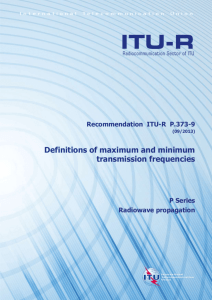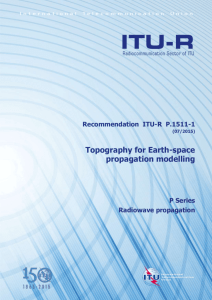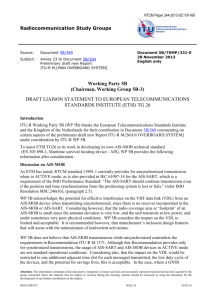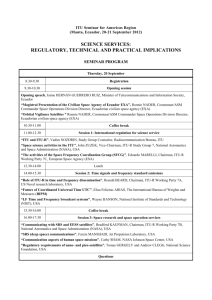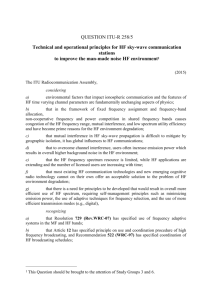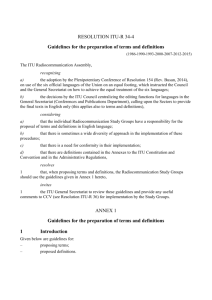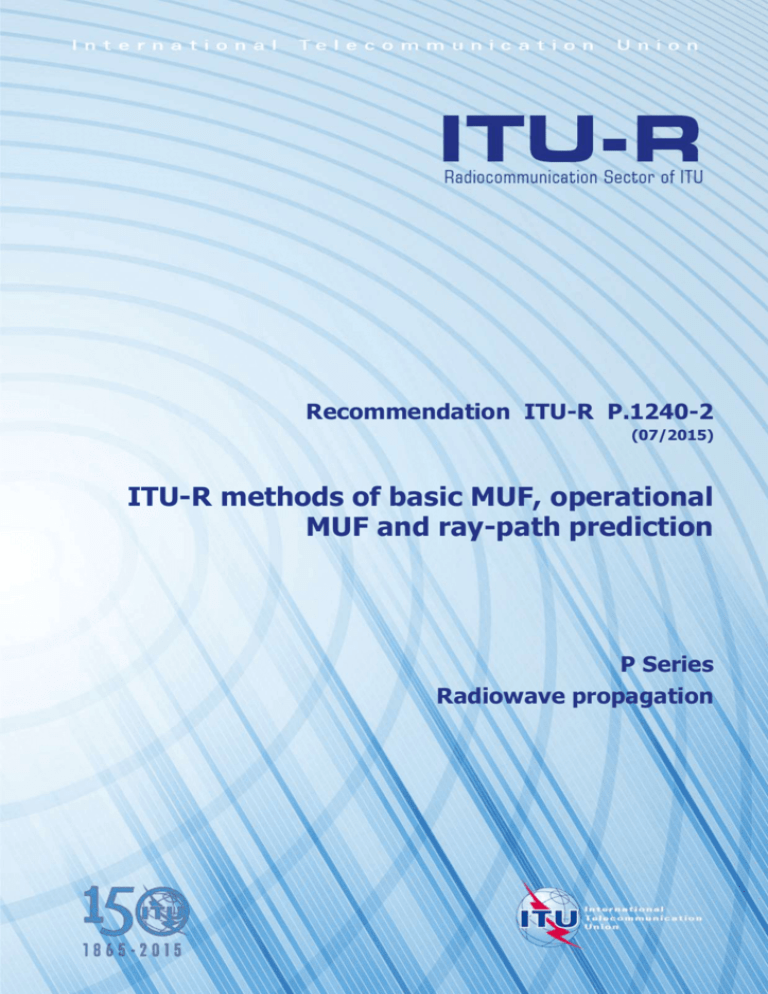
Recommendation ITU-R P.1240-2
(07/2015)
ITU-R methods of basic MUF, operational
MUF and ray-path prediction
P Series
Radiowave propagation
ii
Rec. ITU-R P.1240-2
Foreword
The role of the Radiocommunication Sector is to ensure the rational, equitable, efficient and economical use of the radiofrequency spectrum by all radiocommunication services, including satellite services, and carry out studies without limit
of frequency range on the basis of which Recommendations are adopted.
The regulatory and policy functions of the Radiocommunication Sector are performed by World and Regional
Radiocommunication Conferences and Radiocommunication Assemblies supported by Study Groups.
Policy on Intellectual Property Right (IPR)
ITU-R policy on IPR is described in the Common Patent Policy for ITU-T/ITU-R/ISO/IEC referenced in Annex 1 of
Resolution ITU-R 1. Forms to be used for the submission of patent statements and licensing declarations by patent holders
are available from http://www.itu.int/ITU-R/go/patents/en where the Guidelines for Implementation of the Common
Patent Policy for ITU-T/ITU-R/ISO/IEC and the ITU-R patent information database can also be found.
Series of ITU-R Recommendations
(Also available online at http://www.itu.int/publ/R-REC/en)
Title
Series
BO
BR
BS
BT
F
M
P
RA
RS
S
SA
SF
SM
SNG
TF
V
Satellite delivery
Recording for production, archival and play-out; film for television
Broadcasting service (sound)
Broadcasting service (television)
Fixed service
Mobile, radiodetermination, amateur and related satellite services
Radiowave propagation
Radio astronomy
Remote sensing systems
Fixed-satellite service
Space applications and meteorology
Frequency sharing and coordination between fixed-satellite and fixed service systems
Spectrum management
Satellite news gathering
Time signals and frequency standards emissions
Vocabulary and related subjects
Note: This ITU-R Recommendation was approved in English under the procedure detailed in Resolution ITU-R 1.
Electronic Publication
Geneva, 2015
ITU 2015
All rights reserved. No part of this publication may be reproduced, by any means whatsoever, without written permission of ITU.
Rec. ITU-R P.1240-2
1
RECOMMENDATION ITU-R P.1240-2
ITU-R methods of basic MUF, operational MUF
and ray-path prediction*
(Question ITU-R 212/3)
(1997-2007-2015)
Scope
This Recommendation gives methods for the prediction of the maximum usable frequencies for the
ionospheric layers.
The ITU Radiocommunication Assembly,
considering
a)
that long-term reference ionospheric data and propagation prediction methods are needed for
HF radio-circuit design, service planning and frequency band selection;
b)
that maps of ionospheric characteristics are given in Recommendation ITU-R P.1239,
recommends
1
that for the prediction of basic and operational MUFs, use should be made of the formulations
contained in Annex 1 (for definitions, see Recommendation ITU-R P.373);
2
that for the prediction of ray paths, use should be made of the formulations contained in
Annex 2.
Annex 1
Prediction of basic and operational MUFs
1
Introduction
Empirical formulae are presented for the evaluation of the monthly median basic MUF for the
propagation path.
This MUF is estimated as the greatest of the basic MUF values for the propagation modes appropriate
to the path length being considered.
The relationship between the operational MUF and basic MUF is given and a computer program is
described leading to estimates of path basic MUF, operational MUF and optimum working frequency
on a point-to-point propagation path of any length.
*
Computer programs associated with the prediction procedures and data described in this Recommendation
are available from that part of the ITU-R website dealing with Radiocommunication Study Group 3.
2
2
Rec. ITU-R P.1240-2
Mode consideration
The modes considered are:
1F2
Higher order F2 modes
1F1
1E
2E
0 to dmax
beyond dmax
2 000-3 400 km
0-2 000 km
2 000-4 000 km
where the maximum ground range dmax (km) for a single hop F2 mode is given by:
dmax 4 780 (12 610 2 140 / x2 – 49 720 / x4 + 688 900 / x6) (1 / B – 0.303)
with:
Error!
and
x foF2/foE, or 2 whichever is the larger.
Ionospheric characteristics for the mid-point of the great-circle path are used.
3
Prediction of F2-layer basic MUF
3.1
Ground distance D up to dmax
The F2-layer basic MUF is given by:
Error!
where:
fH :
appropriate gyrofrequency (see Recommendation ITU-R P.1239)
and
CD 0.74 – 0.591 Z – 0.424 Z 2 – 0.090 Z 3 + 0.088 Z 4 + 0.181 Z 5 + 0.096 Z 6
with Z 1 – 2D / dmax
C3000 : value of CD for D 3 000 km where D is the great-circle distance (km).
The above formulae apply for the basic MUF for the x-wave at zero distance, for the o-wave at dmax
and beyond and for some composite waves at intermediate distances. The corresponding o-wave basic
MUF is given for all distances by deleting the last term in fH from the first formula.
3.2
Ground distance D greater than dmax
Values of F2(dmax)MUF are determined for two control-point locations at d0/2 from each terminal
along the connecting great-circle path where d0 is the hop-length of the lowest order F2 mode. The
path MUF is the lower of the two values.
4
Prediction of F1-layer basic MUF
Ionospheric propagation via the F1-layer is important for transmission distances in the 2 000-3 400 km
range at mid and high latitudes during the summer months. For these transmission distances the
F1-layer basic MUF is taken as the product of the mid-path value of foF1 (see Recommendation
ITU-R P.1239) and the M factor MF1. This M factor was derived from ray-tracing calculations on
electron density versus height profiles obtained from representative noon ionograms recorded at mid
and high latitudes. It is assumed that these factors are applicable for all solar zenith angles. The M
factor can be determined from the following numerical expressions:
Rec. ITU-R P.1240-2
3
MF1 J0 – 0.01 ( J0 – J100) R12
where:
J0 0.16 2.64 10 –3 D – 0.40 10 – 6 D2
J100 – 0.52 2.69 10 –3 D – 0.39 10 – 6 D2
and where D represents the great-circle distance (km) in the range of 2 000-3 400 km.
5
Prediction of E-layer basic MUF
5.1
Ground distance up to 2 000 km
Ionospheric propagation via a single reflection from the E-layer is important over distances up to
2 000 km. The E-layer basic MUF of a particular mode may be estimated as the product of the
mid-path value of foE (see Recommendation ITU-R P.1239) and the M factor ME. This M factor
based on ray-path calculations for a parabolic model E-layer with hmE 110 km, ymE 20 km,
when effects of the Earth’s magnetic field are neglected, is given by:
ME 3.94 2.80 x – 1.70 x2 – 0.60 x3 0.96 x 4
where:
Error!
and D represents the great-circle distance (km).
5.2
Ground distance between 2 000 and 4 000 km
The 2E MUF, for ranges between 2 000 and 4 000 km, is taken as E(2000)MUF expressed in terms
of the mid-path foE.
6
Prediction of the operational MUF
For prediction purposes the operational MUF (see Recommendation ITU-R P.373) when determined
by an F2-mode is expressed in terms of the basic MUF. Table 1 gives the ratio of the operational
MUF to the basic MUF for different seasons, times of day and transmitter radiated power, and these
ratios may be used where specific experience for the circuit being considered is not available. When
the operational MUF is determined by an E or F1 mode it is taken equal to the corresponding basic
MUF.
4
Rec. ITU-R P.1240-2
TABLE 1
Ratio of the median operational MUF to the median
basic MUF for an F2-mode, Rop
Summer
Equivalent
isotropically
radiated power
(dBW)
7
Equinox
Winter
Night
Day
Night
Day
Night
Day
30
1.20
1.10
1.25
1.15
1.30
1.20
30
1.25
1.15
1.30
1.20
1.35
1.25
Prediction of the optimum working frequency (OWF)
The OWF (Recommendation ITU-R P.373) is estimated in terms of the operational MUF using the
conversion factor Fl set equal to 0.95 if the path basic MUF is determined by an E or F1 mode, and
as given in Table 2 of Recommendation ITU-R P.1239 if the path basic MUF is determined by an F2
mode.
8
Prediction of the highest probable frequency (HPF)
The HPF (Recommendation ITU-R P.373) is estimated in terms of the operational MUF using the
conversion factor Fl set equal to 1.05 if the path basic MUF is determined by an E or F1 mode, and
as given in Table 3 of Recommendation ITU-R P.1239 if the path basic MUF is determined by an F2
mode.
9
Computer program
The procedures described in this Annex are implemented in the computer program MUFFY, which
predicts basic MUF, operational MUF and optimum working frequency as a function of time of day,
for given propagation path, month and sunspot number.
Annex 2
Prediction of ray path
For a simplified estimation of oblique ray paths, reflection may be assumed to take place from an
effective plane mirror located at height hr.
In the following:
x foF2/foE
with:
and
and
M
H
1 490
– 316
M(3000)F2 M
0.18 0.096 ( R12 – 25)
y – 1.4
150
y x or 1.8, whichever is the larger.
Rec. ITU-R P.1240-2
a)
5
For x 3.33 and xr f / foF2 1, where f is the wave frequency:
hr h or 800 km, whichever is the smaller
where: h A1 B1 2.4–a for B1 and a 0
A1 B1 otherwise
with:
A1 140 ( H – 47) E1
B1 150 ( H – 17) F1 – A1
E1 – 0.09707 xr3 0.6870 xr2 – 0.7506 xr 0.6
F1 is such that:
F1 – 1.862 xr4 12.95 xr3 – 32.03 xr2 33.50 xr – 10.91 for xr 1.71
F1 1.21 0.2 xr
for xr 1.71
and
a varies with distance d and skip distance ds as:
a (d – ds) / ( H 140)
where: ds 160 (H 43) G
G – 2.102 xr4 19.50 xr3 – 63.15 xr2 90.47 xr – 44.73 for xr 3.7
G 19.25
for xr 3.7
b)
For x 3.33 and xr 1
hr h or 800 km, whichever is the smaller
where: h A2 B2 b for B2 0
A2 B2 otherwise
with:
A2 151 ( H – 47) E2
B2 141 ( H – 24) F2 – A2
E2 0.1906 Z 2 0.00583 Z 0.1936
F2 0.645 Z 2 0.883 Z 0.162
where: Z xr or 0.1, whichever is the larger and b varies with normalized distance df,
Z and H as follows:
b – 7.535 d 4f 15.75 d 3f – 8.834 d 2f – 0.378 df 1
where:
c)
Error!
For x 3.33
hr 115 H J U d or 800 km, whichever is the smaller
with:
J – 0.7126 y3 5.863 y2 – 16.13 y 16.07
and
U 8 10–5 ( H – 80) (1 11 y –2.2) 1.2 10–3 H y –3.6

